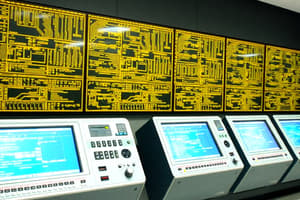Podcast
Questions and Answers
What is the main focus of Unit 1 in the CC 201 course?
What is the main focus of Unit 1 in the CC 201 course?
- Computing: A Historical Perspective (correct)
- Modern software development practices
- The role of computer networks in society
- The invention of early computer graphics
Who is credited with constructing the first mechanical computer?
Who is credited with constructing the first mechanical computer?
- Alan Turing
- Charles Babbage (correct)
- John von Neumann
- Ada Lovelace
What was the first programmable, general-purpose computer called?
What was the first programmable, general-purpose computer called?
- Z3
- UNIVAC
- ENIAC (correct)
- Colossus
How did the ENIAC impact military operations during WWII?
How did the ENIAC impact military operations during WWII?
What significant operating system was developed by AT&T in the 1970s?
What significant operating system was developed by AT&T in the 1970s?
What was a major contribution by IBM to personal computing in 1981?
What was a major contribution by IBM to personal computing in 1981?
What was demonstrated in the 'Mother of All Demos' presented by Douglas Engelbart?
What was demonstrated in the 'Mother of All Demos' presented by Douglas Engelbart?
Who is often considered the world's first programmer?
Who is often considered the world's first programmer?
Flashcards are hidden until you start studying
Study Notes
Computing: A Historical Perspective
- Charles Babbage built the first mechanical computer in the 1820s.
- ENIAC (Electronic Numerical Integrator and Computer) was the first programmable, general-purpose computer.
- ENIAC was used by the US Army during WWII to calculate firing tables, optimizing gun operations.
- Operating Systems (OS) are the "brain" of a computer, managing all components based on user input.
- Unix, developed by AT&T in the 1970s, is a significant operating system.
- IBM introduced the personal computer (PC) in 1981, revolutionizing computing by making it affordable for personal use.
- Douglas Engelbart's "Mother of All Demos" showcased key personal networked computer technologies, including networking, graphical user interfaces, and video conferencing.
- Local Area Networks (LANs) connect computers within a single building.
- Wide Area Networks (WANs) connect multiple LANs across large geographic areas.
- Ada Lovelace is often regarded as the first programmer in history.
- Unix and its variants have widespread adoption due to their powerful capabilities and low to no associated cost.
Studying That Suits You
Use AI to generate personalized quizzes and flashcards to suit your learning preferences.




